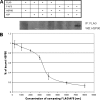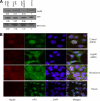Hsp90 directly modulates the spatial distribution of AF9/MLLT3 and affects target gene expression
- PMID: 20159978
- PMCID: PMC2852934
- DOI: 10.1074/jbc.M110.101642
Hsp90 directly modulates the spatial distribution of AF9/MLLT3 and affects target gene expression
Abstract
AF9/MLLT3 contributes to the regulation of the gene encoding the epithelial sodium channel alpha, ENaCalpha, in renal tubular cells. Specifically, increases in AF9 protein lead to a reduction in ENaCalpha expression and changes in AF9 activity appear to be an important component of aldosterone signaling in the kidney. Whereas AF9 is found in the nucleus where it interacts with the histone H3 lysine 79 methyltransferase, Dot1, AF9 is also present in the cytoplasm. Data presented in this report indicate that the heat shock protein Hsp90 directly and specifically interacts with AF9 as part of an Hsp90-Hsp70-p60/Hop chaperone complex. Experimental manipulation of Hsp90 function by the inhibitor novobiocin, but not 17-AAG, results in redistribution of AF9 from a primarily nuclear to cytoplasmic location. Knockdown of Hsp90 with siRNA mimics the effect elicited by novobiocin. As expected, a shift in AF9 from the nucleus to the cytoplasm in response to Hsp90 interference leads to increased ENaCalpha expression. This is accompanied by a decrease in AF9 occupancy at the ENaCalpha promoter. Our data suggest that the interaction of Hsp90, Hsp70, and p60/Hop with AF9 is necessary for the proper subnuclear localization and activity of AF9. AF9 is among a growing number of nuclear proteins recognized to rely on the Hsp90 complex for nuclear targeting.
Figures







Similar articles
-
Dot1a-AF9 complex mediates histone H3 Lys-79 hypermethylation and repression of ENaCalpha in an aldosterone-sensitive manner.J Biol Chem. 2006 Jun 30;281(26):18059-68. doi: 10.1074/jbc.M601903200. Epub 2006 Apr 24. J Biol Chem. 2006. PMID: 16636056 Free PMC article.
-
CBX8, a component of the Polycomb PRC1 complex, modulates DOT1L-mediated gene expression through AF9/MLLT3.FEBS Lett. 2013 Sep 17;587(18):3038-44. doi: 10.1016/j.febslet.2013.07.034. Epub 2013 Jul 25. FEBS Lett. 2013. PMID: 23891621 Free PMC article.
-
Aldosterone-induced Sgk1 relieves Dot1a-Af9-mediated transcriptional repression of epithelial Na+ channel alpha.J Clin Invest. 2007 Mar;117(3):773-83. doi: 10.1172/JCI29850. J Clin Invest. 2007. PMID: 17332896 Free PMC article.
-
Novobiocin and additional inhibitors of the Hsp90 C-terminal nucleotide-binding pocket.Curr Med Chem. 2008;15(26):2702-17. doi: 10.2174/092986708786242895. Curr Med Chem. 2008. PMID: 18991631 Free PMC article. Review.
-
Inhibitors of the HSP90 molecular chaperone: current status.Adv Cancer Res. 2006;95:323-48. doi: 10.1016/S0065-230X(06)95009-X. Adv Cancer Res. 2006. PMID: 16860662 Review.
Cited by
-
AF9 promotes hESC neural differentiation through recruiting TET2 to neurodevelopmental gene loci for methylcytosine hydroxylation.Cell Discov. 2015 Jul 28;1:15017. doi: 10.1038/celldisc.2015.17. eCollection 2015. Cell Discov. 2015. PMID: 27462416 Free PMC article.
-
Hsp90, the concertmaster: tuning transcription.Front Oncol. 2015 Apr 28;5:100. doi: 10.3389/fonc.2015.00100. eCollection 2015. Front Oncol. 2015. PMID: 25973397 Free PMC article. Review.
-
Regulation of αENaC transcription.Vitam Horm. 2015;98:101-35. doi: 10.1016/bs.vh.2014.12.004. Epub 2015 Feb 14. Vitam Horm. 2015. PMID: 25817867 Free PMC article. Review.
-
Multifaceted roles of YEATS domain-containing proteins and novel links to neurological diseases.Cell Mol Life Sci. 2022 Mar 12;79(3):183. doi: 10.1007/s00018-022-04218-0. Cell Mol Life Sci. 2022. PMID: 35279775 Free PMC article. Review.
-
Characterization of Copy Number Variations in Oral Cavity Squamous Cell Carcinoma Reveals a Novel Role for MLLT3 in Cell Invasiveness.Oncologist. 2019 Dec;24(12):e1388-e1400. doi: 10.1634/theoncologist.2019-0063. Epub 2019 Jul 4. Oncologist. 2019. PMID: 31273053 Free PMC article.
References
-
- Krivtsov A. V., Twomey D., Feng Z., Stubbs M. C., Wang Y., Faber J., Levine J. E., Wang J., Hahn W. C., Gilliland D. G., Golub T. R., Armstrong S. A. (2006) Nature 442, 818–822 - PubMed
-
- DiMartino J. F., Miller T., Ayton P. M., Landewe T., Hess J. L., Cleary M. L., Shilatifard A. (2000) Blood 96, 3887–3893 - PubMed
Publication types
MeSH terms
Substances
Grants and funding
LinkOut - more resources
Full Text Sources
Research Materials

